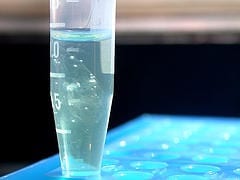Devices a thousand times smaller than those of today’s microtechnologies could be mass-produced
Scientists with the Lawrence Berkeley National Laboratory (Berkeley Lab) and the University of California (UC) Berkeley have directed the first self-assembly of nanoparticles into device-ready materials. Through a relatively easy and inexpensive technique based on blending nanoparticles with block co-polymer supramolecules, the researchers produced multiple-layers of thin films from highly ordered one-, two- and three-dimensional arrays of gold nanoparticles. Thin films such as these have potential applications for a wide range of fields, including computer memory storage, energy harvesting, energy storage, remote-sensing, catalysis, light management and the emerging new field of plasmonics.
“We’ve demonstrated a simple yet versatile supramolecular approach to control the 3-D spatial organization of nanoparticles with single particle precision over macroscopic distances in thin films,” says polymer scientist Ting Xu, who led this research. “While the thin gold films we made were wafer-sized, the technique can easily produce much larger films, and it can be used on nanoparticles of many other materials besides gold.”
Xu holds joint appointments with Berkeley Lab’s Materials Sciences Division and UC Berkeley‘s Departments of Materials Sciences and Engineering, and Chemistry. She is the corresponding author of a paper describing this research in the journal Nano Letters titled “Nanoparticle Assemblies in Thin Films of Supramolecular Nanocomposites.” Co-authoring the paper were Joseph Kao, Peter Bai, Vivian Chuang, Zhang Jiang and Peter Ercius.
Nanoparticles can be thought of as artificial atoms with unique optical, electrical and mechanical properties. If nanoparticles can be coaxed into routinely assembling themselves into complex structures and hierarchical patterns, similar to what nature does with proteins, devices a thousand times smaller than those of today’s microtechnologies could be mass-produced.
Xu and her research group have been advancing towards this goal for the past decade. In a study earlier this year, they were able to induce rod-shaped semiconductor nanocrystals to self-assemble into one-, two- and even three-dimensional macroscopic structures. With this latest application of their methods to thin films, they have moved into the realm of material forms that are required for device fabrication and are well-suited for scalable nanomanufacturing.
via Science Dailyᔥ
Bookmark this page for “Gold Thin Films” and check back regularly as these articles update on a very frequent basis. The view is set to “news”. Try clicking on “video” and “2” for more articles.









